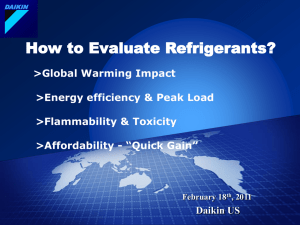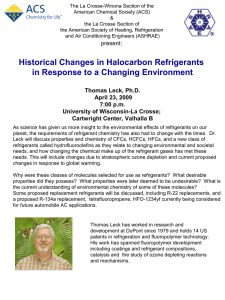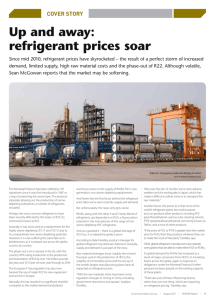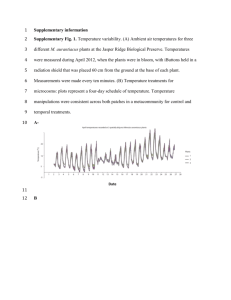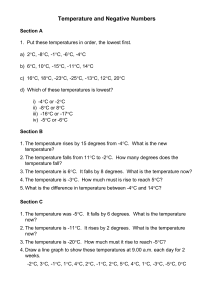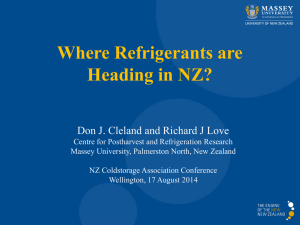Performance of R410A and R22 Low GWP - Purdue e-Pubs
advertisement
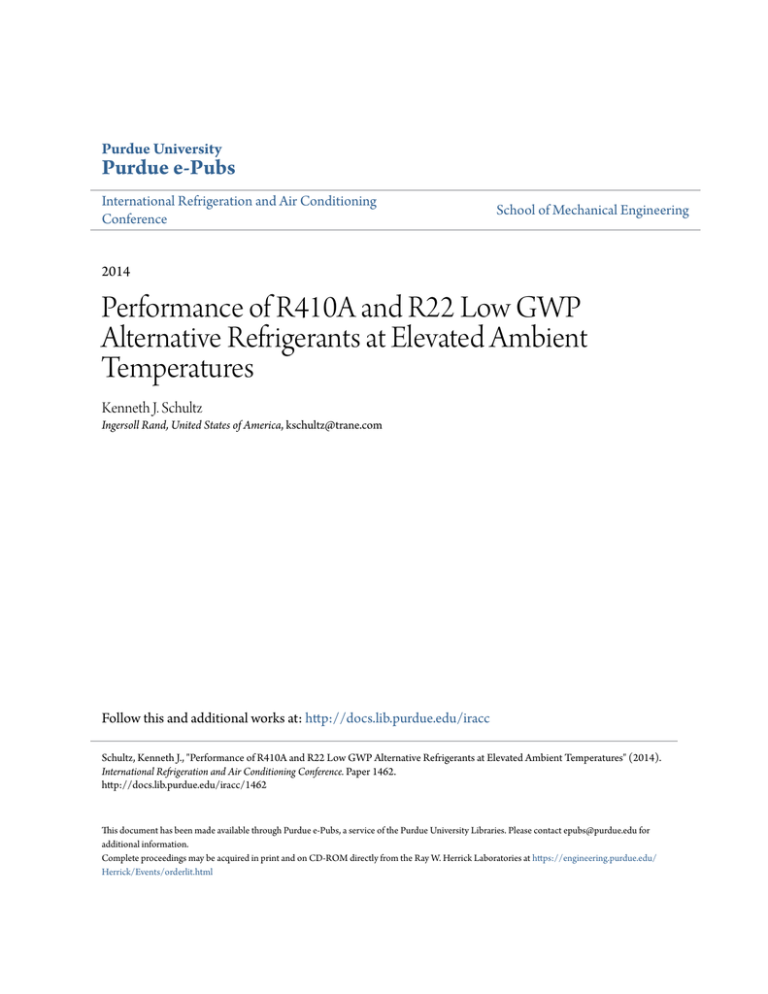
Purdue University Purdue e-Pubs International Refrigeration and Air Conditioning Conference School of Mechanical Engineering 2014 Performance of R410A and R22 Low GWP Alternative Refrigerants at Elevated Ambient Temperatures Kenneth J. Schultz Ingersoll Rand, United States of America, kschultz@trane.com Follow this and additional works at: http://docs.lib.purdue.edu/iracc Schultz, Kenneth J., "Performance of R410A and R22 Low GWP Alternative Refrigerants at Elevated Ambient Temperatures" (2014). International Refrigeration and Air Conditioning Conference. Paper 1462. http://docs.lib.purdue.edu/iracc/1462 This document has been made available through Purdue e-Pubs, a service of the Purdue University Libraries. Please contact epubs@purdue.edu for additional information. Complete proceedings may be acquired in print and on CD-ROM directly from the Ray W. Herrick Laboratories at https://engineering.purdue.edu/ Herrick/Events/orderlit.html 2381, Page 1 Performance of R410A and R22 Low GWP Alternative Refrigerants at Elevated Ambient Temperatures Kenneth SCHULTZ Ingersoll Rand La Crosse, WI, USA 608-787-3735, kschultz@trane.com ABSTRACT Growing concerns about the global warming impact of refrigerants used in HVAC&R equipment are driving development and evaluation of alternative refrigerants with lower global warming potentials (GWPs). The Air Conditioning, Heating, and Refrigeration Institute (AHRI) recently coordinated the Low-GWP Alternative Refrigerant Evaluation Program (AREP) in which commercial, university, and government laboratories ran tests of a range of alternative refrigerants in a variety of HVAC&R products. This paper reports the performance of a 4.4 RT (15.5 kW) air-cooled water chiller / heat pump run with a number of lower GWP alternative refrigerants. Tests were first run with a compressor designed for R410A-like pressures. The refrigerants tested include R410A (baseline) and R32, along with blends labeled DR-5, DR-4, L-41a, L-41b, ARM70a, ARM-32a, and HPR1D. The compressor was then replaced with one designed for R22-like pressures. The refrigerants tested include R22 (baseline) along with blends labeled DR-4, DR-7, ARM-32a, L-20, LTR4X, and LTR6A. The blends contain R32, R1234yf, R1234ze(E), R134a, R152a, R125, and R744 (CO2). The results of this project have been reported previously for performance measured at the nominal operating condition of 7.2°C (45°F) leaving chiller water temperature and 35°C (95°F) ambient air temperature (Schultz and Kujak, 2012, 2013a, 2013b; Schultz, 2014). In this paper, performance over an extended range of air temperatures from 24°C to 46°C (75°F to 115°F) is reported and compared to a simple thermodynamic cycle model. The predicted performance benefits of some refrigerants were not observed at elevated air temperatures in the equipment tested. However, none of the alternative refrigerants performed significantly worse than R410A at elevated ambient air temperatures. 1. INTRODUCTION R22 has seen use in systems ranging from small window air conditioners to large chillers (Calm and Domanski, 2004). Developed countries have now migrated away from R22 to R410A for unitary type equipment to conform to the agreements embodied in the Montreal Protocol (MP) to eliminate ozone depleting substances. R410A is not a drop-in substitute for R22 because of its higher operating pressure and its adoption required the design of new components and systems. Developing countries continue to use R22 because the MP allows its use there in new products until 2030 (UNEP, 2012). In either case, there remains and will remain for years to come a large installed base of equipment charged with R22. From the beginning of the transition from R22 to R410A there has been concern about performance of R410A at elevated ambient temperatures. Yana Motta and Domanski (2000) modeled the performance of R22, R410A, and several other fluids up to ambient temperatures of 55°C. At 50°C, R22 was predicted to lose ~10% of its capacity at 35°C while R410A lost ~13% of its capacity. For R22 at 50°C, the coefficient of performance (COP) dropped by ~30% relative to 35°C. For R410A, the drop was only slightly larger at ~34%. Payne and Domanski (2002) reported the results of actual residential split-system equipment tests with R22 and R410A to elevated ambient temperatures. They used two systems with identical heat exchangers, but with compressors and TXV’s selected specifically for each refrigerant. The two systems had essentially the same 15th International Refrigeration and Air Conditioning Conference at Purdue, July 14-17, 2014 2381, Page 2 capacities at 35°C ambient temperature (~11 kW or ~3 tons), however, the COP of the R410A system proved to be ~3-4% lower than the R22 system at 35°C (~4.4 kW/kW or ~15 Btu/W·hr). At 50°C, the capacity of the R410A system dropped off ~6% more than the R22 system. At 50°C, the COP of the R410A system dropped by ~13% more than the R22 system. However, as noted, the R410A system already had a lower efficiency at the 35°C reference point. The COP of the R22 system at 50°C was ~36% lower than at 35°C. Faramarzi et al. (2004) reported the performance of commercial rooftop units (RTUs) at elevated ambient temperatures. They tested a standard and high efficiency RTU from each of three different manufacturers. All units used R22 as the refrigerant. In general, the capacities of the high efficiency units decreased more slowly with increasing ambient temperature than the standard efficiency units. Curiously, for two of the three manufacturers, the COP decreased more quickly with increasing ambient temperature for the high efficiency units compared to the standard efficiency units. For the third manufacturer, the COP of the standard efficiency unit decreased slightly more quickly than the high efficiency unit. These differences were attributed to the performance characteristics of the individual compressors acting on top of the thermodynamic cycle. A comparison of capacities and COPs at 50°C against 35°C is shown in Table 1 below. Table 1: Degradation in capacity (CAP) and efficiency (COP) at 50°C relative to 35°C of RTUs tested by Faramarzi et al. (2004). CAP@50°C/CAP@35°C –1 COP@50°C/COP@35°C –1 average -11% -28% range -7%..-15% -24%..-30% Rice (2005) described efforts to improve the ability to model and predict system performance with R410A operating at high ambient temperatures with refrigerant condensing temperature approaching the critical point. This work included improved description of the thermodynamic and transport properties of R410A, inclusion of additional details into the system model (eg, refrigerant line heat losses/gains), and creating more accurate compressor maps. Without these improvements, cycle models tend to over predict performance at higher ambient temperatures. Continuing concern about the performance of air-conditioning systems at high ambient temperatures is evidenced by several recent presentations. Nielson (2013) described a project to assess the performance of air conditioning systems in the high ambient temperatures of the Persian Gulf region. Colbourne et al. (2013) discussed R290 (propane) for application in high ambient temperatures. Tests of split-system units indicated that capacity and efficiency both degraded slightly faster as ambient temperature increased for the R290 unit than the R22 unit. Dubai (2013) recently was host to a conference devoted to alternative refrigerants at high ambient temperatures. Topics included an update on environmental policies, the latest refrigerants becoming available, and recent experiences. Chakroun (2014) laid out the challenges in finding low GWP refrigerants for high ambient climates, noting that the annual mean daily maximum temperature in Kuwait is 49.4°C with a maximum summer temperature of 52°C. Elassaad (2014) reviewed application types and market trends, noting that DX-type equipment continues to predominate over water-cooled/district cooling systems. Eltalouny (2014) provided an overview of United Nations efforts to address challenges faced by the air-conditioning industry in hot climates, including technology assessments and promotion of low GWP alternatives to potentially leap-frog intermediate solutions. The Air Conditioning, Heating, and Refrigeration Institute (AHRI) recently coordinated the Low-GWP Alternative Evaluation Program (AREP) in which commercial, university, and government laboratories ran tests of a range of alternative refrigerants in a variety of HVAC&R products (Wang et al., 2012; AHRI). Most of the R410A alternatives testing was done at the conditions listed in AHRI Standard 210/240 with a maximum ambient temperature of 35°C. However, Alabdulkarem et al. (2013) ran tests at 46.1°C ambient with R410A, finding a 13% decrease in capacity relative to the 35°C air temperature conditions and 34% decrease in efficiency. This paper reports the performance of an air-cooled water chiller / heat pump run with a number of lower GWP alternative refrigerants. Tests were run with a number of R410A- and R22-like alternative refrigerants. The results of this project have been reported previously for performance measured at the nominal operating condition of 7.2°C (45°F) leaving chiller water temperature and 35°C (95°F) air temperature (Schultz and Kujak, 2012, 2013a, 2013b; Schultz, 2014). The predictions of a simple thermodynamic cycle model and measured performance were found to 15th International Refrigeration and Air Conditioning Conference at Purdue, July 14-17, 2014 2381, Page 3 be in good agreement at the nominal operating condition with minor deviations due primarily to differences in heat transfer performance. In this paper, performance over an extended range of ambient air temperatures from 24°C to 46°C (75°F to 115°F) will be reported and discussed. 2. DESCRIPTION OF THE TEST PROGRAM The equipment tested was a small air-cooled water chiller / heat pump with a nominal design cooling capacity of 4.4 RT (15.5 kW) and a COP of 3.1 (EER of 10.6 Btu/W·hr) when run with 7°C leaving chilled water temperature and 35°C ambient air temperature. The product is designed to provide chilled or hot water to apartments, offices, or small retail stores. In cooling mode, the evaporator is a brazed plate heat exchanger and the condenser is a coppertube/aluminum-fin coil. This unit was first fitted with a scroll compressor and TXV designed for use with R410A or R32. Following completion of testing with alternative refrigerants proposed as replacements for R410A, the compressor and TXV were replaced with a standard production R22 compressor and TXV and testing continued with alternative refrigerants that have properties closer to R22. A POE oil was used for all testing. The unit was installed in a controlled ambient facility in our laboratory. Key measurements included chilled water flow rate along with inlet and outlet temperatures (RTDs) and pressures, mixed air temperature, electrical power input to the compressor, and total power to the unit. Pressure sensors were mounted at various locations along the refrigerant circuit at the entrances and exits of components; thermocouples were surface-mounted at corresponding locations. A refrigerant flow meter was installed between the condenser and expansion valve, but it appeared from the data that the line and meter pressure drop might have used up all the subcooling available, resulting in inaccurate measurements. Refrigerant flow rates were therefore estimated from an energy balance around the evaporator. For each refrigerant, the initial test set consisted of a refrigerant charge sweep at the nominal operating conditions of 7.2°C leaving chilled water temperature and 35°C ambient air temperature. The refrigerant charge used for further testing was selected at the maximum observed COP (0.25 kg resolution). The test matrix produced several measurements at the nominal operating condition to check repeatability. For most refrigerants, the repeatability in capacity was generally within 1.5%; the repeatability in COP was generally within 2.0%. The refrigerants tested here as alternatives to R410A are listed in Table 2 and R22 alternatives are listed in Table 3. The thermodynamic properties of these refrigerants were provided by the suppliers, typically using a REFPROPbased description (Lemmon et al., 2013). For the most part, these thermodynamic descriptions are based on relatively small data sets. Note that all of the R410A and most of the R22 alternatives are expected to have an ASHRAE Standard-34 “2L” flammability classification (mildly flammable). It should also be noted that all of the blends are zeotropes and have temperature glides of generally between 2.5°Cd and 6.5°Cd, with extremes of <1.5°Cd for DR-5 and 16°Cd for LTR6A. 3. THERMODYNAMIC CYCLE MODEL A simple thermodynamic model is used to compare the various refrigerants to each other. The model ignores differences in heat transfer, pressure drop, and compressor effects and compares only the thermodynamic characteristics of the various fluids. The model assumes the same condenser and evaporator saturation temperatures, evaporator leaving superheat, condenser leaving subcooling, and compressor isentropic efficiency for all refrigerants. For refrigerant blends with glide, the average of the dew and bubble points is matched to the given saturation temperature; e.g., see the cycle state points for L-20 in Figure 1. This methodology is a reasonable approximation, especially considering the counter flow nature of the brazed plate evaporator and the relatively large difference between refrigerant and air temperatures in the condenser. To add some realism to the model, the average dependence of evaporator and condenser approach temperatures, along with compressor suction superheat, condenser leaving subcooling, compressor isentropic efficiency, and compressor volumetric efficiency as functions of the ambient temperature were determined from the data collected. These relationships are shown in Figure 2. 15th International Refrigeration and Air Conditioning Conference at Purdue, July 14-17, 2014 2381, Page 4 Table 2: Refrigerants and blends tested here as possible alternatives to R410A. name supplier composition (%mass) GWP Class‡ R410A n/a R32/R125 (50/50) 2100 A1 R32 National R32 (100) 675 A2L A2L DR-5 DuPont R32/R1234yf (72.5/27.5) 490† DR-4 DuPont R32/R1234yf (43.5/56.5) 295† A2L ARM-70 Arkema R32/R134a/R1234yf (50/10/40) 480† A2L L-41a Honeywell R32/R1234yf/R1234ze(E) (73/15/12) 495† A2L A2L L-41b Honeywell R32/R1234ze(E) (73/27) 495† HPR1D Mexichem R32/R744/R1234ze(E) (60/6/34) 405† A2L † ‡ Calculated from composition (rounded). Expected; not yet formalized for all refrigerants. Table 3: Refrigerants and blends tested here as possible alternatives to R22. name supplier composition (%mass) GWP Class‡ † DR-7 DuPont R32/R1234yf (36/64) 245 A2L ARM-32 Arkema R32/R125/R134a/R1234yf (25/30/25/20) 1575† A1 L-20 Honeywell R32/R152a/R1234ze(E) (45/20/35) 330† A2L LTR4X Mexichem R32/R125/R134a/R1234ze(E) (28/25/16/31) 1295† A1 LTR6A Mexichem R32/R744/R1234ze(E) (30/7/63) 205† A2L DR-4 DuPont R32/R1234yf (43.5/56.5) 295† A2L R22 n/a R22 (100) 1810 A1 D52Y Daikin R32/R125/R1234yf (15/25/60) 980† A2L † Calculated from composition (rounded). ‡Expected; not yet formalized for all refrigerants. Figure 1: Example saturation domes and cycle diagrams on a temperature (T) vs entropy (s) chart. Figure 2. Relationships of cycle operating parameters to ambient temperature determined from the data. Two key thermodynamic parameters that affect performance at high ambient temperatures are the critical temperature (Tcrit, height of the saturation dome) and the latent heat of vaporization (hfg, width of the dome). The values of these parameters for the refrigerants considered in this study are displayed in Figure 3 and plotted in Figure 4. Refrigerants with taller and wider domes tend to offer better performance as ambient temperature increases. The slope of the saturated vapor curve on a T-s plot is also important. Steeper curves tend to offer higher efficiencies and lower compressor discharge temperatures. 15th International Refrigeration and Air Conditioning Conference at Purdue, July 14-17, 2014 2381, Page 5 Figure 3: Critical temperatures (Tcrit) and latent heat of vaporizations (hfg) at 40°C for the refrigerants considered here. Figure 4: Critical temperatures (Tcrit) vs latent heat of vaporizations (hfg) at 40°C for the refrigerants considered here. 4. COMPARISON OF MODEL PREDICTIONS WITH TEST RESULTS The predicted capacities of R410A and the proposed alternatives considered here are shown in Figure 5. The capacities measured from our tests are shown in Figure 6. In each case, the capacities are normalized to the capacity of each refrigerant at 35°C ambient temperature. In Figure 7 and Figure 8, the capacities are further normalized to the capacity of R410A at each temperature (CAP* = CAP/CAP@Tair=35°C). Figure 9 and Figure 10 show the predicted and measured efficiencies, respectively, normalized to R410A at each temperature (COP* = COP/COP@Tair=35°C). R22 is included on the charts for reference. In Figure 7, R32 is seen to thermodynamically offer 6.5% more capacity than R410A at an air temperature of 50°C, just shy of R22’s 7.7% higher capacity. This benefit comes from R32’s wide dome along with its slightly higher critical temperature (8°Cd). DR-4 and ARM-70a are projected to parallel R410A capacity as ambient temperature increases with the other fluids falling in between R410A and R32. In Figure 8, we see that all of the fluids as tested behaved similarly to R410A with respect to capacity (within 2%) as air temperature increased. In particular, the predicted increase in capacity for R32 and several of the other alternatives was not realized in the tested equipment. Note that the R22 curve is extrapolated from a data set with maximum air temperature of 41°C.1 Figure 9 indicates that R22 and R32 should have higher efficiencies than R410A at elevated air temperatures: 7.5% for R22 and 5% for R32 at 50°C. As with capacity, Figure 10 shows that the projected increase in R32 efficiency, among others, was not fully realized in the tested equipment. This could be due to a mismatch between the compressor capacity and fixed heat exchanger size created by the drop-in style test. The equipment produced ~8% higher capacity with R32 (predicted to be 12%) than with R410A at an air temperature of 35°C (Schultz, 2014; Schultz and Kujak, 2013a). All of the R410A alternatives behaved similarly to R410A with respect to sensitivity of efficiency to ambient temperature (3%..0% at 50°C), with none doing significantly better nor worse than R410A. 1 There are two reasons for data to be missing above 41°C. First, fluids with pressures higher than the baseline (such as R32, DR-4, and ARM-32a) would have exceeded the high pressure cutout limit for the compressor at higher ambient temperatures. Second, with the focus on drop-in performance at the nominal design condition, test sets covering high ambient temperatures might have been cut short to keep test plan on track. 15th International Refrigeration and Air Conditioning Conference at Purdue, July 14-17, 2014 2381, Page 6 Figure 5: Predicted capacities (CAP) normalized to 35°C air temperature (Tair) for R410A alternatives. Figure 6: Measured capacities (CAP) normalized to 35°C air temperature (Tair) for R410A alternatives. Figure 7: Predicted capacities relative to R410A. Figure 8: Measured capacities relative to R410A. Figure 9: Predicted efficiencies relative to R410A. Figure 10: Measured efficiencies relative to R410A. 15th International Refrigeration and Air Conditioning Conference at Purdue, July 14-17, 2014 2381, Page 7 Figure 11: Predicted capacities relative to R22. Figure 12: Measured capacities relative to R22. Figure 13: Predicted efficiencies for R22 alternatives. Figure 14: Measured efficiencies normalized to 35°C. Figure 15: Predicted efficiencies relative to R22. Figure 16: Measured efficiencies relative to R22. 15th International Refrigeration and Air Conditioning Conference at Purdue, July 14-17, 2014 2381, Page 8 Figure 17: Predicted compressor discharge temperatures for R410A and its alternatives. Figure 18: Measured compressor discharge temperatures (Tdischarge) for R410A and its alternatives. Figure 19: Predicted compressor discharge temperatures for R22 and its alternatives. Figure 20: Measured compressor discharge temperatures (Tdischarge) for R22 and its alternatives. Figure 11 and Figure 12 show the trends in capacity, predicted and measured, respectively, with ambient temperature for R22 and its alternatives. Efficiencies are shown in Figure 13 through Figure 16. R410A, included as a reference, showed a drop-off in predicted capacity and efficiency of 7-8% relative to R22 at 50°C. All refrigerants are predicted to be at least slightly worse than R22 as ambient temperature increases. The measured performance of DR-7, ARM-32a, and L-20 closely matched the predictions for both capacity and efficiency. L-20 and LTR4X demonstrated the closest match to R22 in both absolute capacity and COP at 35°C air temperature (Schultz, 2014; Schultz and Kujak, 2013a). L-20’s measured performance matched predictions, showing characteristics very similar to R22 as ambient temperature increases. Note that L-20 and R22 have similar critical temperatures and L-20 has a wider saturation dome. It should be noted that R22 (and L-20) performance above 41°C here is extrapolated; the spread between the other refrigerants and R22 might be exaggerated at elevated temperatures. Figure 17 and Figure 18 show the predicted and measured compressor discharge temperatures as ambient air temperature varies for R410A and its alternatives. The model reproduces the measurements for R410A quite closely. The maximum operating temperature for the compressors used here was 125°C (257°F). R32 reached this limit at 41°C air temperature, just slightly ahead of the prediction. DR-5 reached the limit at ~48°C and was predicted to stay below the limit through 50°C. DR-4’s discharge temperature ran slightly below that for R410A. These results 15th International Refrigeration and Air Conditioning Conference at Purdue, July 14-17, 2014 2381, Page 9 would indicate that a shift in the DR-5 composition could mitigate the discharge temperature while accepting a potential small reduction in capacity. Figure 19 and Figure 20 show the predicted and measured compressor discharge temperatures as ambient air temperature varies for R22 and its alternatives. The model reproduces the measurements for R22 quite closely. The predicted discharge temperatures for all of the R22 alternative refrigerants remain below the compressor limit through 50°C. The measured discharge temperatures for L-20 are 3-4°Cd higher than predicted, possibly reaching the limit before 50°C air temperature. 5. CONCLUSIONS Questions about the performance of air-conditioning equipment, whether using R410A or R22, in climates with high ambient temperatures of 50°C+ is of concern in regions like the Middle East and India. This raises the question of how to best proceed forward. A near-term conversion to R410A leverages already developed technology and would allow a potential common transition to a low GWP R410A-like refrigerant. A transition to a low GWP R22-like alternative refrigerant could retain the potential benefit of slightly better performance at higher ambient temperatures, but could lead to use of different refrigerant(s) and equipment by country and climate. The on-going assessments should continue. A simple thermodynamic cycle model, corroborated by experimental data, indicates that the loss in capacity and efficiency using R410A is <8% relative to R22 as ambient temperature increases from 35°C to 50°C. The compressor discharge temperatures with R410A run below those with R22. The results presented here are consistent with the results referenced in the INTRODUCTION. Lower GWP refrigerants were demonstrated by this work to perform similarly to R410A and R22. However, tradeoffs between GWP, temperature glide, and compressor discharge temperature, among other factors, are evident. Flammability also appears to be a tradeoff because some blends contain (more of) the more flammable components than others. Thermodynamically, R32 offers potential for increased capacity and efficiency compared to R410A with high ambient temperature characteristics similar to R22. However, this was not fully realized in the equipment tested. R32 exhibits very high compressor discharge temperatures that would need to be mitigated through cycle modifications and hardware design to allow operation at high ambient temperatures and to account for higher operating pressures. R32 also has the highest GWP (675) tested in this work. DR-5 offers characteristics very similar to R410A with somewhat elevated compressor discharge temperatures that did not exceed the limit until reaching 50°C air temperatures for the equipment tested. A temperature glide of <1.5°Cd, along with DR-5’s lower operating pressures, lower GWP, and likely lower flammability than R32 also make it a more attractive alternative to R410A than R32. L-20 has characteristics very similar to R22. Compressor discharge temperatures are only slightly elevated, possibly being an issue in the equipment tested as air temperatures approach 50°C. L-20’s lower GWP of ~330 is attractive. However, L-20 has higher temperature glide and potentially higher flammability that would need to be dealt with in equipment design and application. REFERENCES AHRI Low-GWP Alternative Refrigerants Evaluation Program, program description and final reports available here… http://www.ahrinet.org/ahri+low_gwp+alternative+refrigerants+evaluation+program.aspx. Jan 2014 Conference presentations are here… http://www.ahrinet.org/ahri_low_gwp+arep+conference.aspx. Alabdulkarem, A., Hwang, Y., Radermacher, R., 2013, TEST REPORT #20 – System Drop-In Tests of Refrigerants R-32, D2Y-60, and L-41a in Air Source Heat Pump, AHRI Low-GWP Alternative Refrigerants Evaluation Program website, see AHRI link above. Calm, J.M., Domanski, P.A., 2004, R-22 Replacement Status, ASHRAE Journal, 46(8):29-39, August. 15th International Refrigeration and Air Conditioning Conference at Purdue, July 14-17, 2014 2381, Page 10 Chakroun, W., 2014, Challenges for High Ambient Temperature Countries, presented in Seminar 18 at 2014 ASHRAE Winter Conference in New York, NY. Available here: http://www.techstreet.com/ashrae/products/1874514. Colbourne, D., Rajadhyaksha, D., Sahu, A., Wadia, B.J., 2013, HC-290 as an Alternative Refrigerant for Split Air Conditioning Systems in High Ambient Temperatures, ATMOsphere Technical Summit – Natural Solutions for Developing Countries, 03-04 Jun 2013, Vienna, http://www.atmo.org/events.details.php?eventid=10, http://www.atmo.org/presentations/files/222_2_GIZ_Colbourne.pdf Dubai, 2013, Alternative Refrigerants for Air-Conditioning Industry in High-Ambient Temperature Countries, 10-11 Sep 2013. Program: http://www.aracihat.com/program.htm. Speakers: http://www.aracihat.com/speakers.htm. Elassaad, B. 2014, Low-GWP Refrigerants in High Ambient Countries: Challenge or Opportunity, presented in Seminar 18 at 2014 ASHRAE Winter Conference in New York, NY. Available here: http://www.techstreet.com/ashrae/products/1874514. Eltolouny, A., 2014, UNEP Perspectives, High Ambient Temperature – Challenges and Opportunities for AirConditioning Industry, presented in Seminar 18 at 2014 ASHRAE Winter Conference in New York, NY. Available here: http://www.techstreet.com/ashrae/products/1874514. Faramarzi, R., Coburn, B., Sarhadian, R., Mitchell, S., Pierce, R.A., 2004, Performance Evaluation of Rooftop Air Conditioning Units At High Ambient Temperatures, ACEEE Summer Study on Energy Efficiency in Buildings, 22-27 Aug 2004, Pacific Grove, CA. http://aceee.org/files/proceedings/2004/data/papers/SS04_Panel3_Paper05.pdf Lemmon, E.W., Huber, M.L., McLinden, M.O., 2013, NIST Standard Reference Database 23: Reference Fluid Thermodynamic and Transport Properties-REFPROP, Version 9.1, National Institute of Standards and Technology, Standard Reference Data Program, Gaithersburg. See http://www.nist.gov/srd/nist23.cfm. Nielson, O.R., 2013, Promoting Low-GWP Refrigerants for Air-Conditioning Sectors in High-Ambient Temperature Countries, ATMOsphere Technical Summit – Natural Solutions for Developing Countries, 03-04 Jun 2013, Vienna, http://www.atmo.org/events.details.php?eventid=10, http://www.atmo.org/presentations/files/221_1_UNIDO_Nielsen.pdf Payne, W.V., Domanski, P.A., 2002, A Comparison of An R22 and an R410A Air Conditioner Operating at High Ambient Temperatures, International Refrigeration and Air Conditioning Conference, Paper 532. Purdue University. http://docs.lib.purdue.edu/cgi/viewcontent.cgi?article=1531&context=iracc Rice, C.K., 2005, Evaluation and Modeling of Split-System Air Conditioner Performance Under Extreme Ambient Temperatures with R410A Operating Up to the Refrigerant Critical Point. Final Report for ARTI-21CR/60550015-01. Air-Conditioning, Heating, and Refrigeration Institute (AHRI). Obtain by request to AHRI Director of Research; see http://www.ahrinet.org/technical+results.aspx Schultz, K., 2014, Performance of R410A and R22 Alternative Lower GWP Refrigerants in a Small (~5 RT) Water Chiller, presented at the ASHRAE Winter Conference, 19-22 Jan 2014, New York City, Conference Paper NY14-C066. http://www.techstreet.com/ashrae/products/1874555. Schultz, K., Kujak, S., 2012, TEST REPORT #1 – System Drop-in Test of R-410A Alternative Fluids (ARM-32a, ARM-70a, DR-5, HPR1D, L-41a, L-41b, and R-32) in a 5-RT Air-Cooled Water Chiller (Cooling Mode), AHRI Low-GWP Alternative Refrigerants Evaluation Program website, see AHRI link above. Schultz, K., Kujak, S., 2013a, TEST REPORT #6 – System Drop-in Tests of R-22 Alternative Fluids (ARM-32a, DR-7, L-20, LTR4X, LTR6A, and D52Y) in a 5-RT Air-Cooled Water Chiller (Cooling Mode), AHRI LowGWP Alternative Refrigerants Evaluation Program website, see AHRI link above. Schultz, K., Kujak, S., 2013b, Comparative performance of low GWP alternate refrigerants for R410A and R22 in a small air-cooled chiller, Proceedings of ICCR3013 – 5th International Conference on Cryogenics and Refrigeration, 06-09 Apr 2013, Hangzhou, China, Paper ID B-4-09. UNEP, 2012, Handbook for the Montreal Protocol on Substances that Deplete the Ozone Layer, Ninth Edition. Wang, X., Amrane, K., Johnson, P., 2012, Low Global Warming (GWP) Alternative Refrigerants Evaluation Program (Low-GWP AREP), International Refrigeration and Air Conditioning Conference, Paper 2233. Purdue University. http://docs.lib.purdue.edu/cgi/viewcontent.cgi?article=2221&context=iracc Yana Motta, S.F., Domanski, P.A., 2000, Performance of R-22 and its Alternatives Working at High Outdoor Temperature, International Refrigeration and Air Conditioning Conference, Paper 464. Purdue University. http://docs.lib.purdue.edu/cgi/viewcontent.cgi?article=1463&context=iracc 15th International Refrigeration and Air Conditioning Conference at Purdue, July 14-17, 2014
